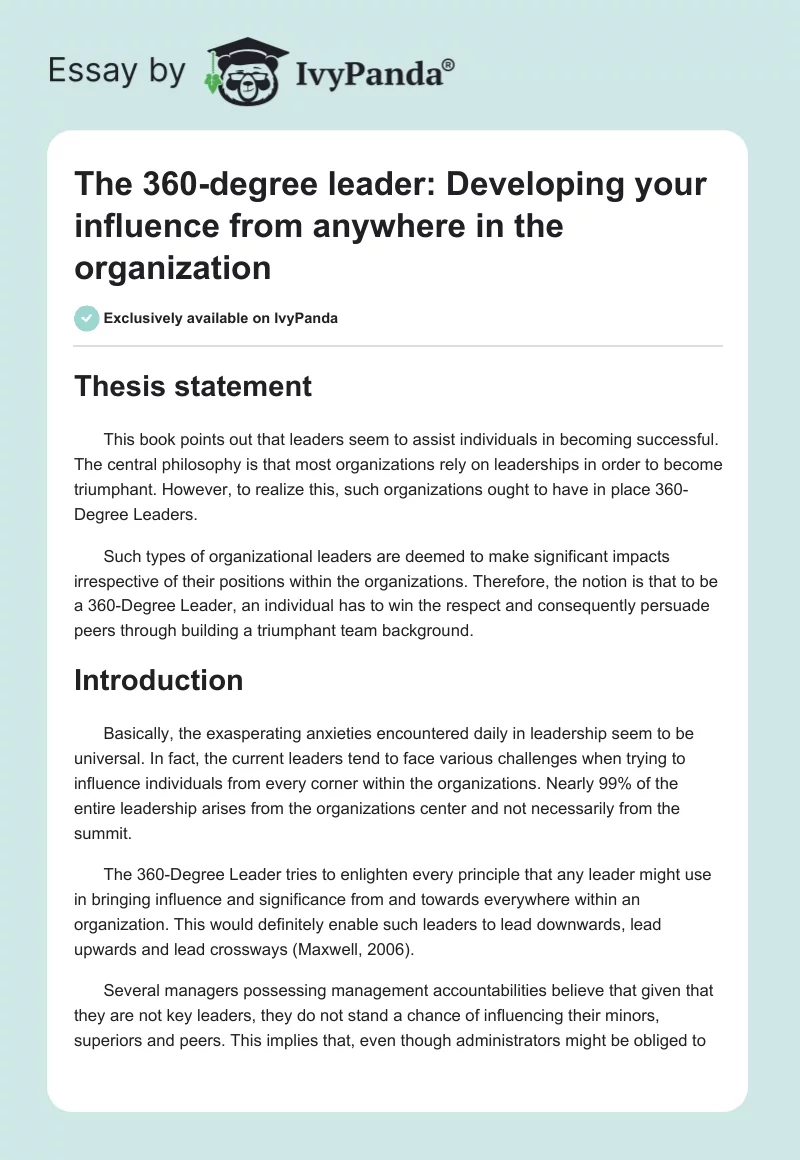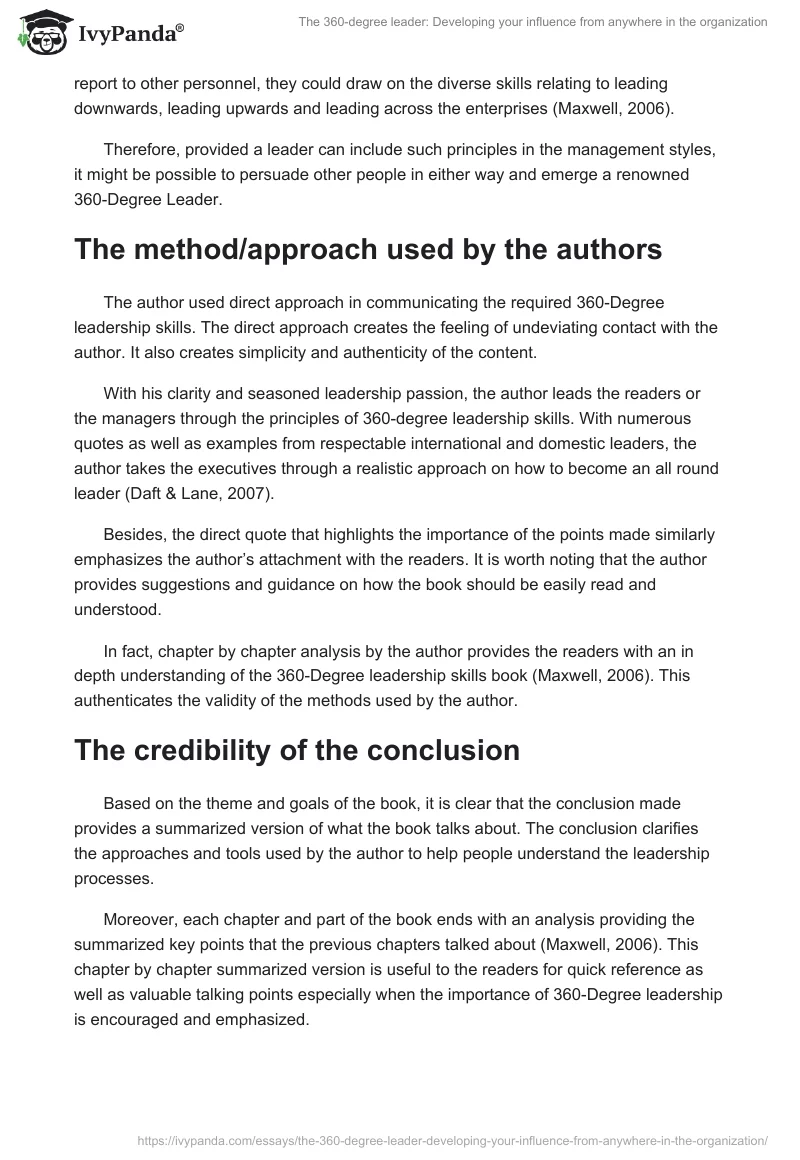Thesis statement
This book points out that leaders seem to assist individuals in becoming successful. The central philosophy is that most organizations rely on leaderships in order to become triumphant. However, to realize this, such organizations ought to have in place 360-Degree Leaders.
Such types of organizational leaders are deemed to make significant impacts irrespective of their positions within the organizations. Therefore, the notion is that to be a 360-Degree Leader, an individual has to win the respect and consequently persuade peers through building a triumphant team background.
Introduction
Basically, the exasperating anxieties encountered daily in leadership seem to be universal. In fact, the current leaders tend to face various challenges when trying to influence individuals from every corner within the organizations. Nearly 99% of the entire leadership arises from the organizations center and not necessarily from the summit.
The 360-Degree Leader tries to enlighten every principle that any leader might use in bringing influence and significance from and towards everywhere within an organization. This would definitely enable such leaders to lead downwards, lead upwards and lead crossways (Maxwell, 2006).
Several managers possessing management accountabilities believe that given that they are not key leaders, they do not stand a chance of influencing their minors, superiors and peers. This implies that, even though administrators might be obliged to report to other personnel, they could draw on the diverse skills relating to leading downwards, leading upwards and leading across the enterprises (Maxwell, 2006).
Therefore, provided a leader can include such principles in the management styles, it might be possible to persuade other people in either way and emerge a renowned 360-Degree Leader.
The method/approach used by the authors
The author used direct approach in communicating the required 360-Degree leadership skills. The direct approach creates the feeling of undeviating contact with the author. It also creates simplicity and authenticity of the content.
With his clarity and seasoned leadership passion, the author leads the readers or the managers through the principles of 360-degree leadership skills. With numerous quotes as well as examples from respectable international and domestic leaders, the author takes the executives through a realistic approach on how to become an all round leader (Daft & Lane, 2007).
Besides, the direct quote that highlights the importance of the points made similarly emphasizes the author’s attachment with the readers. It is worth noting that the author provides suggestions and guidance on how the book should be easily read and understood.
In fact, chapter by chapter analysis by the author provides the readers with an in depth understanding of the 360-Degree leadership skills book (Maxwell, 2006). This authenticates the validity of the methods used by the author.
The credibility of the conclusion
Based on the theme and goals of the book, it is clear that the conclusion made provides a summarized version of what the book talks about. The conclusion clarifies the approaches and tools used by the author to help people understand the leadership processes.
Moreover, each chapter and part of the book ends with an analysis providing the summarized key points that the previous chapters talked about (Maxwell, 2006). This chapter by chapter summarized version is useful to the readers for quick reference as well as valuable talking points especially when the importance of 360-Degree leadership is encouraged and emphasized.
Indeed, the book conclusion provides inspiration to discouraged leaders on ways in which they could create an environment that develops everyone in the organization and enables the growth and development of the organization. Additionally, the concluding parts take into account much of what has been covered in most of the previous chapters besides providing essential reference for the readers that are in need of the 360-Degree leadership refresher course (Daft & Lane, 2007).
The implications of practicing the leadership
It is arguable that leaders inspire others as well as lead others from anywhere within the organization. Good leaders have greater influence on everyone success which in turn leads to the success of the organization. Practicing leaders provide the vision and makes everyone within the organization have similar vision.
In addition, the practicing leader makes everyone work towards the attainment of the shared vision. In other words, such leaders will always be in the forefront in ensuring that the organization goals are achieved.
As indicated in the book, organizations wholly depend on good leadership in order to be successful. That is, any organization should have 360-Degree leaders so as to be able to attain their goals. 360-degree leaders make an impact in whatever position they hold within the organization. Accordingly, being a 360-Degree leader implies winning respect as well as having an influence on peers in order to build a successful team environment.
In reality, people normally trace their achievements and disappointments on the type of affiliation they have with other individuals. Therefore, the type of relationship people have tends to greatly influence the degree of achievement or disappointment, hence worth invested in (Daft & Lane, 2007).
No matter the number of leaders within an organization, what are needed are leaders who add value to the organization. God leaders build strong, effective and efficient teams through hiring those who are above them, being secure in their positions, roles and being ready to listen to others. The developments within the strong teams make members become leaders at all levels of the organization.
Those leaders who are successful at one level normally have the qualities of leading in the next level. For one to be a good leader at the higher level, they must take cognizant of their current position (Maxwell, 2006). To be precise, they must perform beyond their reasonable doubt their current leadership roles.
Good leaders at the middle levels make better leaders at higher levels of the organization. Good practicing leaders normally have close relationship with subordinates and are fully aware of what is happening. This knowledge can be used to influence the top managers as well as those below.
Influence by the middle level practicing leaders’ enables those at the top management to double their efforts as well as focus on their priorities (Maxwell, 2006). This in turn leads to the growth of the entire organization.
Practicing leaders normally possess some characteristics that enable them to achieve their leadership goals together with those of the organization. Practical leaders generate new ideas, are risk takers and offer solutions to the problems that may arise within the organization. Above and beyond, they foresee new ventures and opportunities that the organization may take advantage of.
They are indeed people who can lead from all directions. These leaders are adaptable, discernable, have greater perspectives, offer security to the people and organization, resourceful and mature. The book also emphasizes that practical leaders are those who are accountable and endure all the challenges (Daft & Lane, 2007).
The strengths and weaknesses of the book
The book is simple and easily understandable, uses simple language and phrases that the readers can easily follow. Moreover, the book is broken into parts with each part talking about a particular theme. This makes it much easier for the readers to refer to a particular topic that they feel interested in or are in need of. Chapter by chapter summary also offers a quick reference to a particular topic that is needed by the readers.
Of great significance is the fact that the book is written in an instructional form and follows a step by step analysis of the principles of leadership, making the book more information based (Daft & Lane, 2007). The only weakness the book has is that it is inconsequential and voluminous. One may take time to completely read the book more so the target audiences who mainly comprise of persistently busy managers.
Recommending the book
To all the current and world middle managers, this is ideally the book to read. It offers essential tools that any aspiring middle manager should have. The principles highlighted in this book are applicable in all areas and aspects in any organization. In addition, the book offers step by step analysis of the principles of leadership that are easily understandable and simple to follow. It offers more value for the current managers and those who would wish to be 360-Degree leaders.
Conclusion
Generally, the book looks at what the leaders should do and consequently the qualities they should have to assist individuals and organization in becoming successful. The main viewpoint is that most organizations rely on leaderships so as to become successful. However, to achieve this goal, the organizations must have in place 360-Degree Leaders. It is emphasized that 360-Degree leaders will make significant impacts irrespective of their positions within the organizations.
References
Daft, R. L. & Lane, P. G. (2007). The leadership experience. Florence, KY: Cengage Learning.
Maxwell, J. C. (2006). The 360 degree leader: Developing your influence from anywhere in the organization. Nashville, TN: Thomas Nelson Inc.


